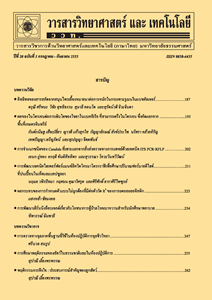อิทธิพลของสารสกัดจากสมุนไพรเอื้องหมายนาต่อการหมักในกระเพาะรูเมนในแบชคัลเจอร์
Main Article Content
Abstract
บทคัดย่อ
การวิจัยนี้มีวัตถุประสงค์เพื่อทดสอบอิทธิพลของสารสกัดจากสมุนไพรเอื้องหมายนาต่อการย่อยสลายโปรตีน วัตถุแห้ง และอินทรียวัตถุ รวมทั้งผลผลิตจาการหมักในกระเพาะรูเมนด้วยจุลินทรีย์ในกระเพาะรูเมน โดยใช้ของเหลวในกระเพาะรูเมนของโคนมและบัฟเฟอร์ (McDougall artificial saliva) อัตราส่วน 1:3 ในขวดที่มีอาหารโคนม 3 กรัม และบ่มที่ 39 องศาเซลเซียส เป็นเวลา 24 ชั่วโมง วางแผนการทดลองแบบ CRD ประกอบด้วย 4 สิ่งทดลอง (จำนวน 5 ซ้ำ) ได้แก่ กลุ่มควบคุม (ไม่มีสารสกัดจากเองหมายนา) สารสกัดจากเอื้องหมายนาส่วนใบ ลำต้น และรากที่สกัดด้วยเอธานอล 95 เปอร์เซ็นต์ ความเข้มข้น 5 มิลลิกรัม/มิลลิลิตร จากการศึกษาพบว่าสารสกัดจากเอื้องหมายนาส่วนใบ ลำต้น และราก ไม่ทำให้ค่า pH แตกต่างจากกลุ่มควบคุม โดยพบอยู่ในช่วง 5.34-5.83 และทำให้ปริมาณแอมโมเนีย (8.80, 5.50 และ 6.13 มิลลิโมลาร์ ตามลำดับ) และการย่อยได้ของโปรตีน (57.99, 50.40 และ 56.23 เปอร์เซ็นต์ ตามลำดับ) ลดลง เมื่อเปรียบเทียบกับกลุ่มควบคุม (11.83 มิลลิโมล/ลิตร และ 61.86 เปอร์เซ็นต์ ตามลำดับ) (P<0.05) แต่ไม่ทำให้การย่อยได้ของวัตถุแห้งและการย่อยได้ของอินทรียวัตถุเปลี่ยนแปลง โดยพบอยู่ในช่วง 60.80-63.48 และ 59.93-61.88 เปอร์เซ็นต์ ตามลำดับ และไม่ทำให้กรดกรดอะซิติค กรดโพรไพโอนิค และกรดบิวทีริคเปลี่ยนแปลง โดยพบอยู่ในช่วง 46.40-50.22, 24.07-25.56 และ 14.58-18.79 มิลลิโมลาร์ ตามลำดับ นอกจากนี้ยังพบการใช้สารสกัดจากเอื้องหมายนาส่วนลำต้นและราก ช่วยเพิ่มการเจริญของจุลินทรีย์รวมในกระเพาะรูเมน โดยพบมีค่า OD (2.41 และ 2.65 ตามลำดับ) มากกว่ากลุ่มควบคุม (1.91) (P<0.05) การศึกษานี้ชี้ให้เห็นว่าสารสกัดจากสมุนไพรเอื้องหมายนามีอิทธิพลต่อการหมักในกระเพาะรูเมนในแบชคัลเจอร์ด้วยการลดการย่อยสลายโปรตีนและเพิ่มจำนวนจุลินทรีย์รวม โดยไม่เปลี่ยนแปลงค่า pH การย่อยได้ของวัตถุแห้ง การย่อยได้ของอินทรียวัตถุ และกรดไขมันระเหยได้
คำสำคัญ : สารสกัดจากเอื้องหมายนา; การหมักในกระเพาะรูเมน; แบชคัลเจอร์
Abstract
This research was conducted in order to investigate the effect of Costus speciosus extracts on protein digestibility (PD), dry matter digestibility (DMD), organic matter digestibility (OMD) and fermentation end products of rumen microorganisms. Mixture of rumen fluid and buffer (McDougall artificial saliva) with the proportion of 1:3 were added into dairy cow feed and incubated at 39 oC for 24 h. Extraction of leaf (LE), stem (SE) and rhizome (RE) of Costus speciosus were carried out by using 95% ethanol. Four treatments including extracts LE, SE and RE at concentrations of 5 mg/ml and control were tested in Completely Randomized Design with five replicates. The results showed that LE, SE and RE extracts did not affect pH when compared to the control. The pHs were in the range of 5.34-5.83. Ammonia concentrations were significantly decreased by LE, SE and RE extracts at the concentration of 8.80 mM, 5.50 mM and 6.13 mM, respectively when compared to the control at the concentration of 11.83 mM (P<0.05). Moreover, the LE, SE and RE extracts significantly decreased PD at 57.99, 50.40 and 56.23 %, respectively when compared to the control at 61.86% (P<0.05). However, the DMD (60.80-63.48 %) and OMD (59.93-61.88 %) revealed no change. All treatments also did not change acetic acid, propionic acid and butyric acid concentrations which were in the range of 46.40-50.22 mM, 24.07-25.56 mM and 14.58-18.79 mM, respectively. However, SE and RE extracts increased rumen bacteria with higher OD (2.41 and 2.65, respectively) than that of the control (1.91). The obtained results indicated that Costus speciosus extracts changed rumen fermentation by the reduction of protein digestibility and increasing total number of rumen bacteria with no changes of pH, dry matter digestibility, organic matter digestibility and volatile fatty acid concentrations.
Keywords: Costus speciosus extract; rumen fermentation; batch culture

